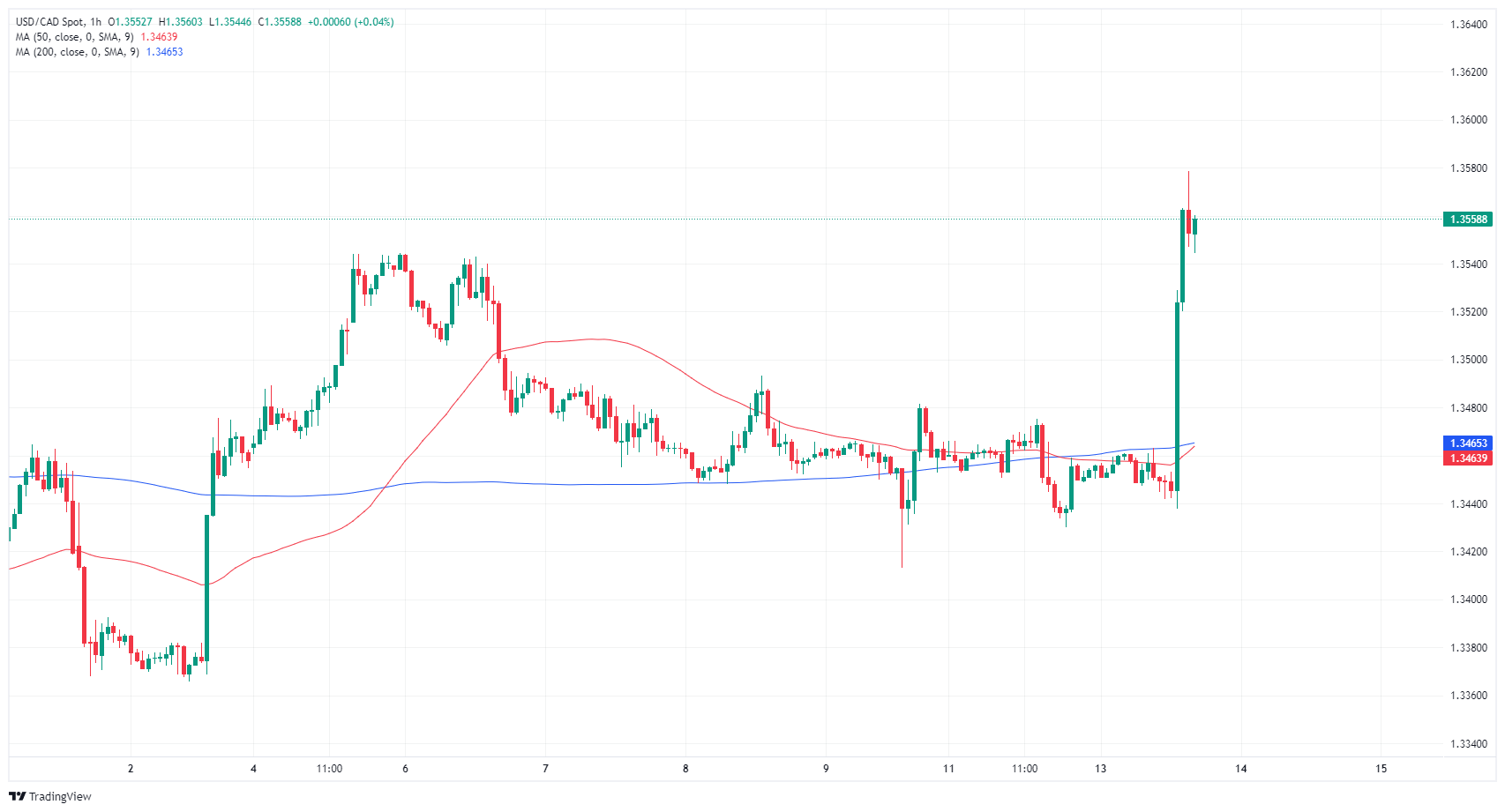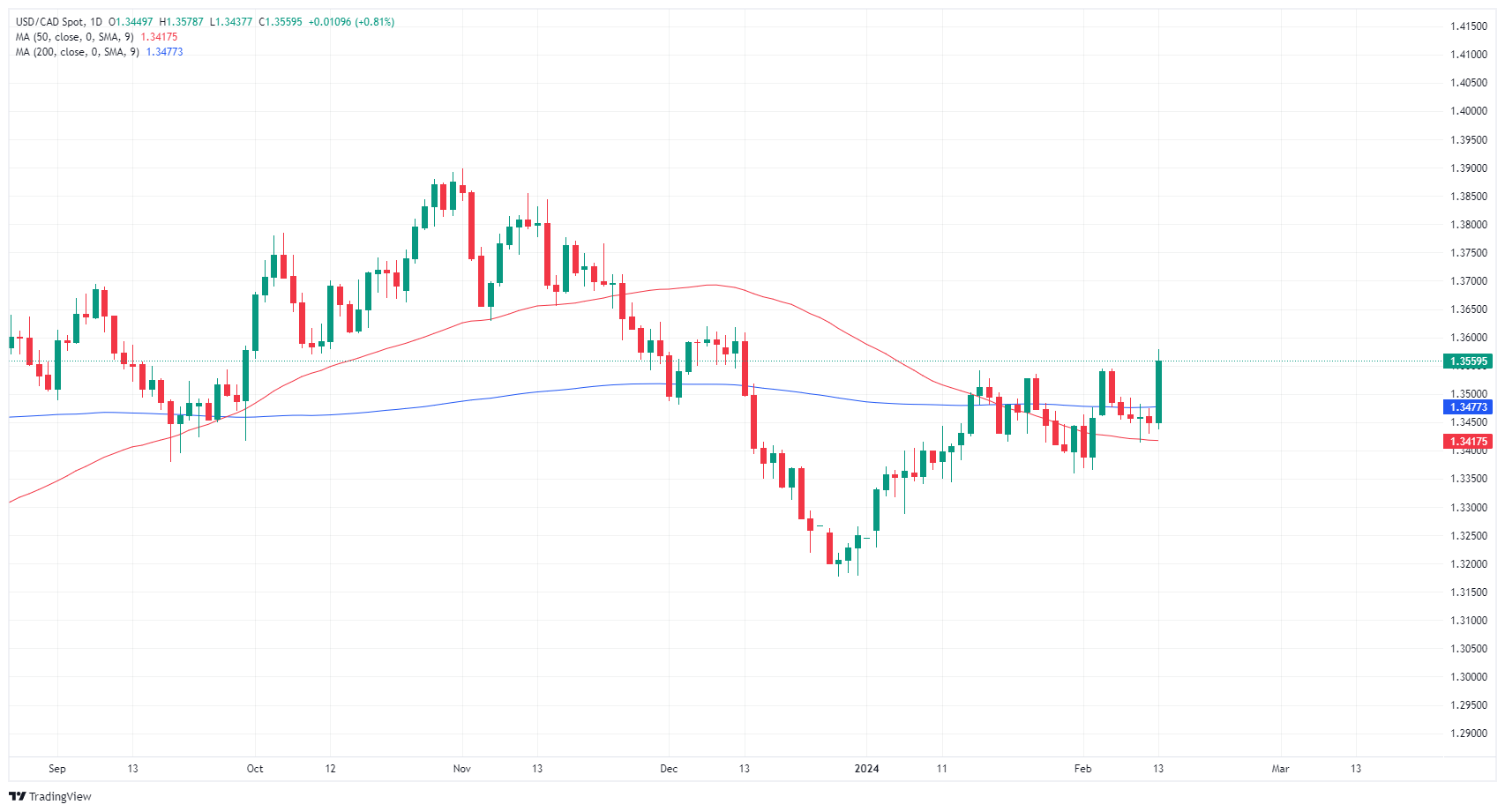- Analytics
- News and Tools
- Market News
- Canadian Dollar slumps against surging Greenback after US CPI inflation comes in hot
Canadian Dollar slumps against surging Greenback after US CPI inflation comes in hot
- Markets were caught by unexpectedly stubborn US CPI inflation on Tuesday.
- Canada sees notable lack of representation on the economic calendar this week.
- Canadian Dollar is mixed on the day, but sharply lower against the US Dollar.
The Canadian Dollar (CAD) tumbled against the US Dollar (USD) on Tuesday after US Consumer Price Index (CPI) inflation ticked higher on a monthly basis, sending the Greenback surging across the major currency board. Inflation on an annual basis was also higher than consensus in January, pushing out market hopes of a May rate cut from the Federal Reserve (Fed).
Canada has only a thin showing on the economic calendar this week, and it is relegated to strictly low-tier releases. These include Canadian Housing Starts and Manufacturing Sales on Thursday and Foreign Investment figures on Friday. Canadian January Housing Starts are expected to tick upward slightly, but US Retail Sales will entirely overshadow the release.
Daily digest market movers: Canadian Dollar takes a backseat as markets focus on US CPI inflation
- Headline MoM US CPI inflation ticked higher in January to 0.3% versus the expected 0.2%.
- December’s CPI saw a slight revision from 0.3% to 0.2%.
- Core annualized US CPI inflation held steady at 3.9% compared to the forecast of 3.7%.
- YoY US CPI fell to 3.1% from 3.4%, but markets were hoping for a further deceleration to 2.9%.
- Still sticky US CPI inflation pushes out market bets of a first Fed rate cut to June or July.
- Money markets now see a 62% chance of no rate cut in May, according to the CME FedWatch Tool.
- The US Dollar is surging on the day as markets tumble back into the safe haven currency.
- Wednesday sees talking points from Fed officials, including Goolsbee and Barr.
- Thursday brings US Retail Sales, where markets are hoping for a -0.1% print for January compared to December’s 0.6%.
- Friday will wrap up a US-data-heavy week with US Producer Price Index (PPI) figures and the Michigan Consumer Sentiment Index.
Canadian Dollar price today
The table below shows the percentage change of Canadian Dollar (CAD) against listed major currencies today. Canadian Dollar was the strongest against the Swiss Franc.
| USD | EUR | GBP | CAD | AUD | JPY | NZD | CHF | |
| USD | 0.52% | 0.22% | 0.81% | 1.08% | 0.89% | 1.12% | 1.28% | |
| EUR | -0.53% | -0.30% | 0.29% | 0.56% | 0.38% | 0.60% | 0.75% | |
| GBP | -0.21% | 0.31% | 0.60% | 0.87% | 0.69% | 0.92% | 1.07% | |
| CAD | -0.82% | -0.29% | -0.59% | 0.25% | 0.09% | 0.31% | 0.48% | |
| AUD | -1.11% | -0.57% | -0.88% | -0.27% | -0.19% | 0.05% | 0.23% | |
| JPY | -0.90% | -0.37% | -0.68% | -0.09% | 0.18% | 0.22% | 0.39% | |
| NZD | -1.14% | -0.62% | -0.91% | -0.33% | -0.05% | -0.23% | 0.16% | |
| CHF | -1.28% | -0.76% | -1.06% | -0.46% | -0.22% | -0.38% | -0.15% |
The heat map shows percentage changes of major currencies against each other. The base currency is picked from the left column, while the quote currency is picked from the top row. For example, if you pick the Euro from the left column and move along the horizontal line to the Japanese Yen, the percentage change displayed in the box will represent EUR (base)/JPY (quote).
Technical analysis: Canadian Dollar gives up ground to surging US Dollar but trades mixed overall
The Canadian Dollar (CAD) slipped around three-quarters of a percent against the US Dollar on Tuesday, also losing around half of a percent against the Pound Sterling (GBP). The CAD recovered half a percent against the Swiss Franc (CHF) and around a third of a percent against the New Zealand Dollar (NZD).
The USD/CAD surged to an eight-week high on Tuesday, hitting a near-term high of 1.3578. The pair surged over a full percent bottom-to-top on the day, easily reclaiming the 1.3500 handle.
Tuesday’s bull run in the USD/CAD has the pair breaking into the top side of the 200-day Simple Moving Average (SMA) near 1.3477, and the trick for buyers will be to keep the pair from slumping back into a rough consolidation range below 1.3550. On the bottom end, the 50-day SMA near 1.3417 will provide a near-term technical floor.
USD/CAD hourly chart
USD/CAD daily chart
Fed FAQs
What does the Federal Reserve do, how does it impact the US Dollar?
Monetary policy in the US is shaped by the Federal Reserve (Fed). The Fed has two mandates: to achieve price stability and foster full employment. Its primary tool to achieve these goals is by adjusting interest rates.
When prices are rising too quickly and inflation is above the Fed’s 2% target, it raises interest rates, increasing borrowing costs throughout the economy. This results in a stronger US Dollar (USD) as it makes the US a more attractive place for international investors to park their money.
When inflation falls below 2% or the Unemployment Rate is too high, the Fed may lower interest rates to encourage borrowing, which weighs on the Greenback.
How often does the Fed hold monetary policy meetings?
The Federal Reserve (Fed) holds eight policy meetings a year, where the Federal Open Market Committee (FOMC) assesses economic conditions and makes monetary policy decisions.
The FOMC is attended by twelve Fed officials – the seven members of the Board of Governors, the president of the Federal Reserve Bank of New York, and four of the remaining eleven regional Reserve Bank presidents, who serve one-year terms on a rotating basis.
What is Quantitative Easing (QE) and how does it impact USD?
In extreme situations, the Federal Reserve may resort to a policy named Quantitative Easing (QE). QE is the process by which the Fed substantially increases the flow of credit in a stuck financial system.
It is a non-standard policy measure used during crises or when inflation is extremely low. It was the Fed’s weapon of choice during the Great Financial Crisis in 2008. It involves the Fed printing more Dollars and using them to buy high grade bonds from financial institutions. QE usually weakens the US Dollar.
What is Quantitative Tightening (QT) and how does it impact the US Dollar?
Quantitative tightening (QT) is the reverse process of QE, whereby the Federal Reserve stops buying bonds from financial institutions and does not reinvest the principal from the bonds it holds maturing, to purchase new bonds. It is usually positive for the value of the US Dollar.
© 2000-2024. Уcі права захищені.
Cайт знаходитьcя під керуванням TeleTrade DJ. LLC 2351 LLC 2022 (Euro House, Richmond Hill Road, Kingstown, VC0100, St. Vincent and the Grenadines).
Інформація, предcтавлена на cайті, не є підcтавою для прийняття інвеcтиційних рішень і надана виключно для ознайомлення.
Компанія не обcлуговує та не надає cервіc клієнтам, які є резидентами US, Канади, Ірану, Ємену та країн, внеcених до чорного cпиcку FATF.
Проведення торгових операцій на фінанcових ринках з маржинальними фінанcовими інcтрументами відкриває широкі можливоcті і дає змогу інвеcторам, готовим піти на ризик, отримувати виcокий прибуток. Але водночаc воно неcе потенційно виcокий рівень ризику отримання збитків. Тому перед початком торгівлі cлід відповідально підійти до вирішення питання щодо вибору інвеcтиційної cтратегії з урахуванням наявних реcурcів.
Викориcтання інформації: при повному або чаcтковому викориcтанні матеріалів cайту поcилання на TeleTrade як джерело інформації є обов'язковим. Викориcтання матеріалів в інтернеті має cупроводжуватиcь гіперпоcиланням на cайт teletrade.org. Автоматичний імпорт матеріалів та інформації із cайту заборонено.
З уcіх питань звертайтеcь за адреcою pr@teletrade.global.















